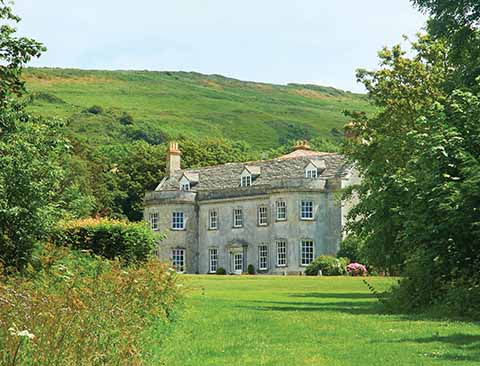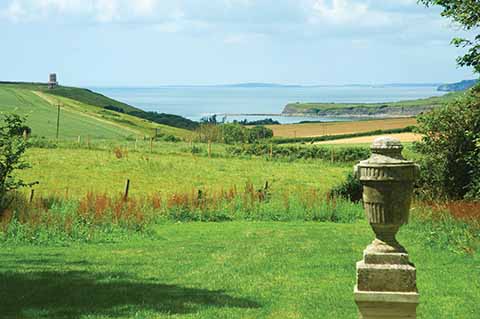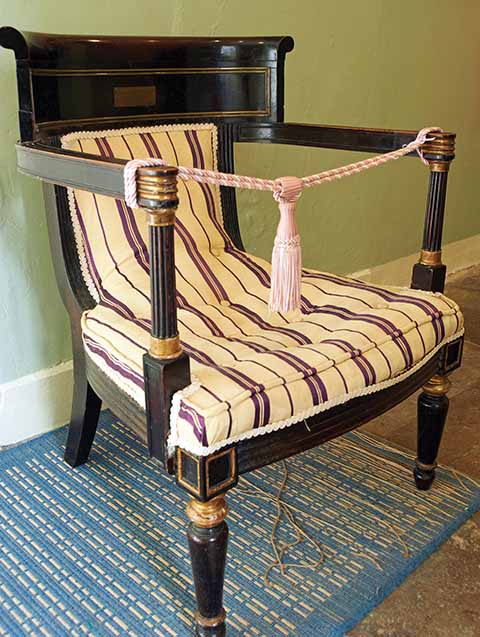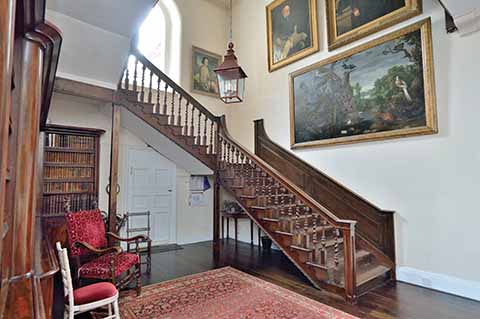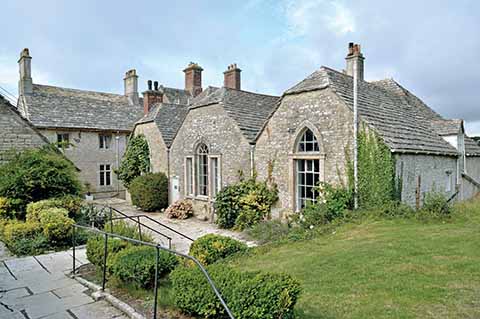Dorset house – Smedmore House
Peter Booton explores one of Dorset’s finest Georgian manor houses
Published in December ’19
THE 1800-ACRE Smedmore Estate in Purbeck encompasses virtually the whole of Kimmeridge and its bay. The estate is unique. Here can be seen a working oil well, once the most productive in the UK, and the tower that inspired a P D James murder story and is now the Landmark Trust’s most popular holiday property. A seam of bituminous oil-shale running through Kimmeridge’s cliffs provided jewellery for the Romans and, in the 1860s, gas to illuminate the streets of Paris. These cliffs were responsible for the demise of Victor Meldrew’s car in a 1997 episode of BBC TV’s comedy series, One Foot in the Grave, and, in 2015, witnessed an Antony Gormley sculpture, created to mark the Landmark Trust’s 50th anniversary, topple into the sea twice. Since the reign of Henry II, owners of the Smedmore estate have enjoyed the right to collect any wreckage washed up on the seashore.
At the heart of the estate is grade II* listed Smedmore House, an elegant Georgian stone-fronted building dating in part from around 1610. It was built by Sir William Clavell (1568-1644) on land owned by the de Smedmore family until 1391, when it was sold to a tenant, William Wyot. Wyot’s heiress, his daughter Johanna, married John Clavell of Leeson and in 1554 their great-great-grandson, also named John, purchased the manor of Kimmeridge. From this time the Smedmore and Kimmeridge estates have been owned continuously by the Clavells and their descendants.

Carving on beech tree, evidently by ‘Roy H Arnett USA’, whilst he was on service with the US Army during World War 2
Sir William’s purpose in building his ‘little newe house’ at Kimmeridge was undoubtedly influenced by the commercial opportunities he believed the estate offered. His first venture was the extraction of alum from the cliffs for fixing dyes in cloth. But the enterprise failed and he turned instead to boiling sea-water to extract salt and later attempted to make glass by using coal rather than timber in the process. Every venture lost money, lots of it, and Sir William was forced to sell off large parts of his estate before handing over what little was left to his successor.
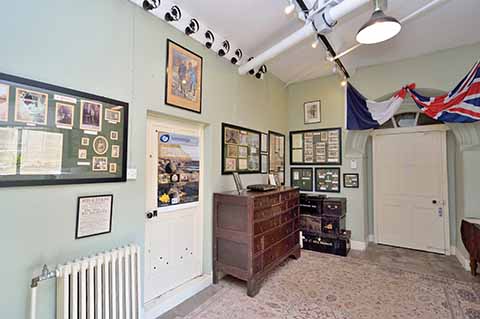
The War Room, which commemorates Philip’s great aunts, Juliet and Marcia Mansel, who nursed at the Western Front during World War 1, and his father, Major J C Mansel, who served with The Rifle Brigade during World War 2
Normally this would have been his nephew, John Clavell, but he was disinherited for being a highwayman and so the estate passed instead to Sir William’s second cousin once removed, Roger Clavell of Winfrith, a working farmer. In 1664 Roger was elected Sheriff of Dorset and Deputy Lieutenant of Purbeck the following year. His grandson, Edward, built on the Queen Anne garden façade around 1700 and may have been responsible, too, for adding the brewery, servants’ room and stables as well as the old kitchen, which at that time was separate from the main building. In 1744 Smedmore passed to his third son, George, who in 1761 added the elegant Georgian façade with its two semi-circular window bays which visitors today first see as they approach the house from the drive.
Sitting atop Hen Cliff, a mile almost due west of Smedmore House, is Kimmeridge’s most recognisable feature, Clavell Tower, which was built by Rev. John Clavell in 1831 to mark the occasion of his seventieth birthday. On his death in 1833, and following a legal battle over the Reverend’s nonexistent will, Smedmore was rightfully inherited by his niece, Louisa Pleydell, who was the wife of Colonel John Mansel. The estate has been owned by the Mansel family ever since and the present owner is Eton- and Oxford-educated Dr Philip Mansel, an accomplished historian who has written fourteen books mainly relating to the Ottoman Empire and the French Monarchy. His latest book, King of the World: The Life of Louis XIV, was published in July 2019.
Since taking over in 1989 from his father, Major J C Mansel, Philip has taken a great interest in the estate, on which he has planted a significant number of trees. In 1995 he launched a campaign to save the disused Clavell Tower from tumbling into the sea by moving it away from the crumbling cliff-edge. The Landmark Trust came to the rescue and in 2006 began carefully dismantling the circular four-storey tower and then re-assembling it stone by stone (over 1600 in total), 25 yards further inland. Following completion in 2008, the tower’s interior was modernised to make it suitable for holiday accommodation. Clavell Tower is now the Landmark Trust’s most popular property and anyone wishing to spend some time there (there’s only room for two) will need to book around eighteen months in advance. Originally built to serve as a summer house and possibly an observatory, the tower later served as a coastguards’ lookout and was the inspiration for P D James’s prize-winning 1975 novel, The Black Tower. In 1985 it was the setting for Anglia Television’s six-part adaptation of the story and also featured in Style Council’s video accompanying their single, ‘Boy Who Cried Wolf’.
Not surprisingly for a property of its age, the interior of Smedmore House has been remodelled at different periods and amongst its notable features today are an 18th-century oak staircase, a marble fireplace in the drawing room and an ‘unrestrained’ (according to Pevsner) Rococo chimney-piece in one of the six first-floor bedrooms. The Cedar Room is in fact panelled with oak and the walls of the Dining Room are hung with more than a hundred 18th-century blue Furstenberg plates, each with a different pattern, from the German china factory of the Dukes of Brunswick.
Smedmore House has been a comfortably furnished and cherished family home for more than 400 years. Ancestral portraits and modern paintings by local artists line the walls and there are many items of 17th-century Dutch furniture which hail from the home of Philip’s great-great-great aunt, Lady Elizabeth Villiers, who inherited them from the last English descendant of one of William III’s generals. Gracing the Outer Hall is a copy of a chair used by Napoleon while in exile on St Helena, the original of which was presented to Colonel John Mansel, who was stationed on the island.
Philip has created two very special rooms within the house: a small museum known as the War Room, which was once the butler’s pantry, and the colourfully furnished Turkish Room, which reflects his interest in the Ottoman Empire and contains various items from the period when he lived in Turkey. The War Room is devoted to Philip’s father, Major J C Mansel, who served in the Rifle Brigade during World War 2, and his two great-aunts, Marcia and Juliet Mansel, who were nurses at the Western Front during World War 1. Marcia and Juliet were born at Smedmore in 1890 and 1893 respectively and served initially with the British Red Cross and then, after 1917, with the French Red Cross as they felt that the French hospitals offered a greater challenge because they were closer to the battle-front. Marcia and Juliet posted a number of letters home to their mother, Mildred Ella Mansel (nicknamed ‘Mully’), who typed a selection of them as their personal war memorial. These letters, now displayed in the War Room, speak volumes about the courage and dedication of the selfless Mansel sisters.
Following the return of Major Mansel to his regiment in 1939, Smedmore House was let for a short while to the Tolmers Park School for Girls of Potters Bar before being requisitioned by the British Army in 1940 and later used as a base for American troops preparing for D-Day, during which time one of the soldiers carved ‘Roy H Arnett USA’ on a beech tree near the stables. After being de-requisitioned in 1949, the house was let to the historian, Sir Arthur Bryant who, with the assistance of two Canadian sisters named Miss Naomi and Miss Audrey Horrocks, began rescuing the garden from military occupation and restoring it to its former glory. In 1958 Major Mansel and his family returned to Smedmore and Mrs Mansel, a keen gardener, could then lovingly continue to revive the garden. In the summer of that year they opened their home to the public for the first time. On the first day there were three visitors! To signal when a guided tour was about to begin, Major Mansel would ring a bell he had found washed up in the bay.
In the shady arboretum near the house is the unmarked gravestone of a tiger brought back from India in about 1880 by Philip’s great-grandfather. Sadly, it didn’t survive its first winter in Britain. Smedmore, it seems, has its own micro-climate and in the sheltered gardens, a blaze of colour during summer, a surprising variety of exotic plants, including oranges, lemons and limes, somehow survive and produce fruit. There is even a banana palm tree, although Philip admits to seeing it fruit only once.
The house and gardens at Smedmore can be visited by the public at certain times during the year and open days are in aid of local charities. A number of concerts organised by Purbeck Art Weeks will be held in the house during 2020 (the next is on 29 March). Smedmore can also be hired throughout the year for weddings, corporate events and all kinds of celebrations – a wonderful opportunity to spend quality time in one of Dorset’s most historic houses. And with nine bedrooms available, there’s a lot more space than there is in Clavell Tower. Such usage benefits the estate by helping to provide funds for its ongoing upkeep. Philip is hoping one day to be able to restore the old stables. Meanwhile, he is seeking expert advice on how to encourage wildflowers and make the estate more organic in the future. He will of course succeed: as the Mansel family motto says, ‘What he wants, he wants very much’. www.smedmorehouse.com
